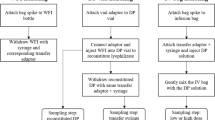Abstract
The purpose of this study was to comparatively evaluate the pharmaceutical characteristics of various marketed generic formulations of prostaglandin analogue latanoprost in the Indian market. Three generics of latanoprost and one branded (Xalatan) formulation (five vials each) were obtained from authorized agents from the respective commercial sourcing having the same batch number. These formulations were coded, and the labels were removed. At a standardized room temperature of 25 °C, the concentration, osmolarity, drop size, pH, and total drops per vial were determined for Xalatan and all the generics of latanoprost. The concentration of various brands varied between 50.49 ± 0.36 and 58.90 ± 0.52 µg/ml as compared to the standard labeled concentration of 50 µg/ml on the latanoprost vials. The concentration of drugs in individual drop varied from 1.30 ± 0.05 to 1.78 ± 0.04 µg/drop. The volume of drug formulation per bottle varied from 2.4 ± 0.12 to 2.6 ± 0.09 ml/bottle. The number of drops per bottle varied from minimum of 88.60 ± 0.10 drops to maximum of 102.0 ± 4.3 drops across all the formulations, while the drop size varied from 25.72 ± 2.70 to 29.97 ± 1.38 µl. The osmolarity of 2/4 drugs was within 300 mOs M (±10 %). The specific gravity varied between 0.98 ± 0.01 and 1.007 ± 0.01, while pH was between 7.05 ± 0.004 and 7.13 ± 0.005. Two of the generic brands were outside the United States pharmacopoeia limits (±10%) for ophthalmic formulation, with concentration exceeding the limits by 3 % (p = 0.151) and 8 % (p = 0.008), respectively. This pilot study highlights that there are significant variations in the drug concentrations and physical properties of generic latanoprost formulations. Although none of the brands had concentrations below the recommended level, two of the brands had concentrations exceeding the limits by 3 and 8 %, respectively.


Similar content being viewed by others
Change history
27 December 2021
A Correction to this paper has been published: https://doi.org/10.1007/s10792-021-02146-9
References
Pascolini D, Mariotti SP (2012) Global estimates of visual impairment: 2010. Br J Ophthalmol 96:614–618
Quigley HA, Borman AT (2006) The number of people with glaucoma worldwide in 2010 and 2020. Br J Ophthalmol 90:262–267
Patel SS, Spencer CM (1996) Latanoprost. A review of its pharmacological properties, clinical efficacy and tolerability in the management of primary open-angle glaucoma and ocular hypertension. Drugs Aging 9(5):363–378
Zore M, Harris A, Tobe LA, Siesky B, Januleviciene I, Behzadi J et al (2013) Generic medications in ophthalmology. Br J Ophthalmol 97(3):253–257. doi:10.1136/bjophthalmol-2012-302245
Bae JP (1997) Drug patent expirations and the speed of generic entry. Health Serv 32:87–101
Ascione FJ, Kirking DM, Gaither CA, Welage LS (2001) Historical overview of generic medication policy. J Am Pharm Assoc 41:567–577
Genazzani AA, Pattarino F (2008) Difficulties in the production of identical drug products from a pharmaceutical technology viewpoint. Drugs R D 9:65–72
Cantor LB (1997) Ophthalmic generic drug approval process: implications for efficacy and safety. J Glaucoma 6:344–349
Brechue WF, Maren TH (1993) pH and drug ionization affects ocular pressure lowering of topical anhydrase inhibitors. Invest Ophthalmol Vis Sci 34:2581–2587
Paolera MD, Kasahara N, Umbelino CC, Walt JC (2008) Comparative study of the stability of bimatoprost 0.03% and latanoprost 0.005%: a patient-use study. BMC Ophthalmol 8:11
Johnson TV, Gupta PK, Vudathala DK, Blair IA, Tanna AP (2011) Thermal stability of bimatoprost, latanoprost, and travoprost under simulated daily use. J Ocul Phrmacol Ther 27:51–59
Perry CM, McGavin JK, Culy CR, Ibbotson T (2003) Latanoprost: an update of its use in glaucoma and ocular hypertension. Drugs Aging 20(8):597–630
Alm A, Grierson I, Shields B (2008) Adverse events associated with prostaglandin analogue therapy. Surv Ophthalmol 53(Suppl 1):S93–S105
Alm A, Schoenfelder J, McDermott J (2004) A 5-year, multicenter, open-label, safety study of adjunctive latanoprost therapy for glaucoma. Arch Ophthalmol 122:957–965
Kahook MY, Fechtner RD, Katz LJ, Noecker RJ, Ammar DA (2012) A comparison of active ingredients and preservatives between brand name and generic topical glaucoma medications using liquid chromatography-tandem mass spectrometry. Curr Eye Res 37(2):101–108
Duvall B, Kershner RM (2006). Pharmaceutical characteristics and delivery. In: Textbook of ophthalmic medications and pharmacology, SLACK Incorporated; 2nd edn, 1:2-3
Narayanaswamy A, Neog A, Baskaran M, George R, Lingam V, Desai C et al (2007) A randomized, crossover, open label pilot study to evaluate the efficacy and safety of Xalatan® in comparison with generic latanoprost (Latoprost) in subjects with primary open angle glaucoma or ocular hypertension. Indian J Ophthalmol 55:127–131
Fiscella RG, Jensen M, Van Dyck G (1998) Generic prednisolone suspension substitution. Arch Ophthalmol 116:703
Stringer W, Bryant R (2010) Dose uniformity of topical corticosteroid preparations; difluprednate ophthalmic emulsion 0.05% versus branded and generic prednisolone acetate ophthalmic suspension 1%. Clin Ophthalmol 4:1119–1124
Velpandian T, Kotnala A, Halder N, Ravi AK, Vikneswari A, Sihota R (2014) Stability of latanoprost in generic formulations using controlled degradation and patient usage simulation studies. Curr Eye Res 11:1–11
Acknowledgments
We acknowledge our statistician viz. Mrs. Veena Pandey, B.Sc, All India Institute of Medical Sciences, New Delhi.
Author information
Authors and Affiliations
Corresponding author
Ethics declarations
Conflict of interest
No conflicting relationship exists for any author.
Additional information
The original online version of this article was revised: In the original publication, one of the authors name was published incorrectly. The correct name should read as Ankita Kotnala.
Rights and permissions
About this article
Cite this article
Angmo, D., Wadhwani, M., Velpandian, T. et al. Evaluation of physical properties and dose equivalency of generic versus branded latanoprost formulations. Int Ophthalmol 37, 423–428 (2017). https://doi.org/10.1007/s10792-016-0280-x
Received:
Accepted:
Published:
Issue Date:
DOI: https://doi.org/10.1007/s10792-016-0280-x




